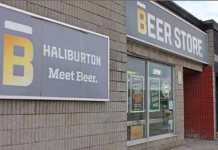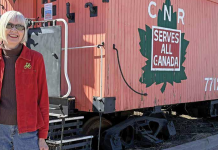Algonquin Highlands council has finalized plans for green burials at St. Stephen’s cemetery, with the option becoming available to people in spring 2025.
The township has been working with volunteers from the Haliburton Highlands Green Burial Society for much of the year to iron out details for the proposed site, located on Buckslide Road. A joint committee reached consensus and made recommendations to council in October.
Their plan, approved unanimously by council Nov. 2, called for 180 plots to be set aside on a .31-acre parcel on the north side of the cemetery property. Plots will be 4.5 feet by eight feet and split into 10 sections. They will be accessed by a 12-foot-wide gravel laneway, with each section separated by a four-foot “natural” path made of organic matter.
Addressing council, green burial society chair Terry Moore said this was the culmination of almost five years of work. He and his wife, Shirley, have been advocating for green burials since 2019. Following the passing of their son, Kyle, the Moores realized there were no environmentallyfriendly burial practices available to County residents, so formed the society to change that.
“This is a day our burial society members have been looking forward to for some time. We are quite excited,” Moore said. “In terms of taking care of the environment, we feel green burials are very important… it’s not the greenest option we can possibly imagine, but it’s a much greener option than fire cremation.”
Moore noted around 75 per cent of people in Haliburton County opt to be cremated after passing away.
Explaining how green burials work, Moore said it’s a simple process – bodies are typically wrapped in a biodegradable shroud, or placed in a biodegradable casket, then laid directly into a grave site. The spot remains unmarked, meaning it can be used again in the future.
One caveat with this new section is plots will be sold and used on an as-needed basis, from the back of the property forwards. This means people won’t be able to purchase designated plots, likely preventing loved ones from being buried beside one another. Public works director, Adam Thorn, said this was being done so staff didn’t have to worry about potentially driving equipment over grave sites, possibly damaging or exposing them, when digging out other plots.
Moore said this wasn’t a deal breaker for any green burial activist he’s asked.
“While the ability to be buried beside another family member would be nice to have, the opportunity to be buried in a green burial space with maximum possible naturalized green space was our members’ number one priority,” Moore said.
He noted other green burial sections, such as Canada’s first established site in Victoria, British Columbia, and another in Niagara Falls, used the same method.
Mayor Liz Danielsen said this would require the township to update internment rights in the township’s bylaws, which council agreed to do. The mayor noted this was for the green burial section only, with people retaining the right to be buried beside loved ones in the regular section of St. Stephen’s cemetery.
All changes must first be approved by the Bereavement Authority of Ontario before they can be adopted.
There was some discussion about whether staff should maintain the natural pathways between plot sections, with council opting for greenery to be mowed only in advance of a burial, and only up to and around that plot.
Winter burials
Council also provided conditional support for winter burials to take place starting in 2025, but only in the green burial section of St. Stephen’s cemetery.
Thorn noted he still had some work to do to narrow down cost, indicating his preference would be to contract grave site preparation out to a third party. Currently, township staff handle all work for burials at Algonquin Highlands’ four cemeteries. Thorn said without hiring additional staff, he wasn’t sure his team could handle the extra workload winter burials would bring. He was also worried about logistics, given the equipment used to prepare grave sites is also utilized in the winter for road maintenance.
“We have enough staff now to do the work we’re doing. Things like plowing some extra parking lots, we can handle that, but a burial is different. If we have a set timeframe when a burial needs to be done, what happens if we have a big snow event, and we have to divert all our staff to maintain roads?” Thorn said.
“We only have two pieces of equipment that can open graves… they are vital to loading trucks for sanding operations. We’d really be stuck – it would have to be a nice sunny day for us to open and close a grave properly,” he added.
Council directed Thorn to put together a full report on winter burial options to be brought back for consideration.




